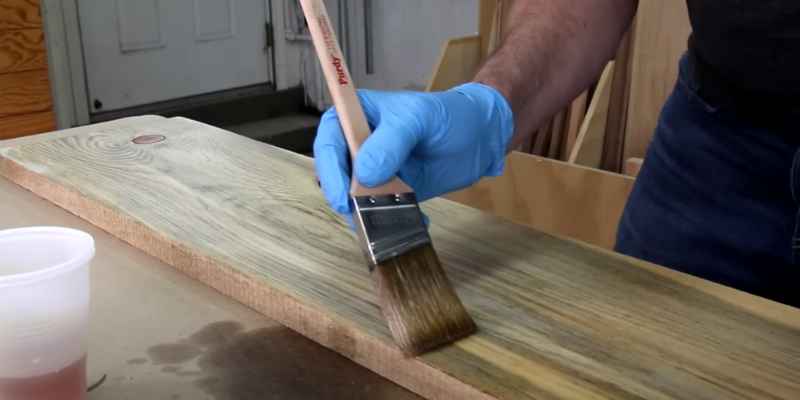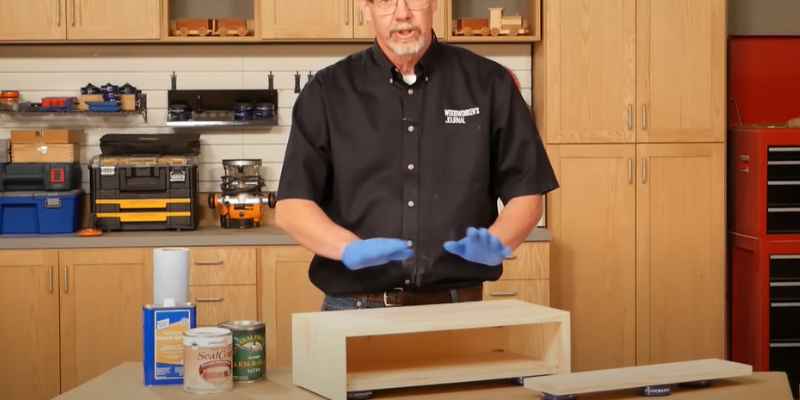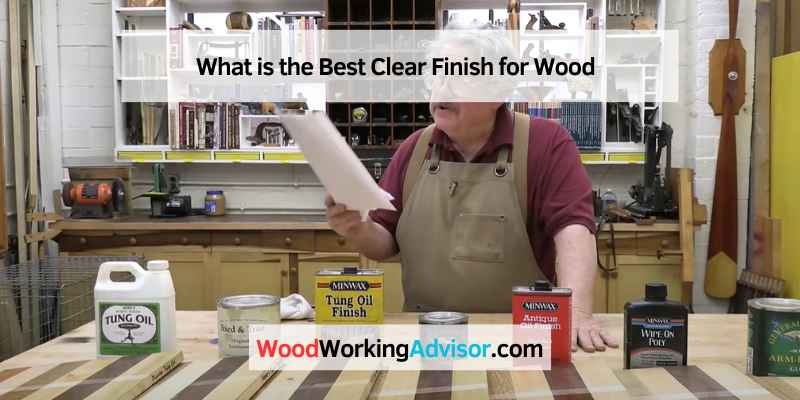There are a lot of different clear finishes that can be used on wood, and it can be not very clear to try and figure out which one is the best. In general, the best clear finish for wood is going to be something that is durable and will protect the wood from damage. A few different types of finishes fit this description, so it comes down to personal preference in the end.
Some popular choices for the best clear finish for wood include polyurethane, lacquer, and varnish.
There are a lot of different clear finishes that you can use on wood, and it can be tough to decide which one is the best for your project. Here is a rundown of some of the most popular clear finishes and what they are best suited for. Shellac: Shellac is a classic finish that has been used for centuries.
It is made from resins secreted by female lac bugs and alcohol. It dries quickly and gives the wood a warm, amber hue. It is perfect for furniture and other projects that will be handled often, as it can withstand a lot of wear and tear.
However, shellac is not waterproof, so it’s not ideal for outdoor projects or items exposed to moisture. Polyurethane: Polyurethane is one of the most durable clear finishes available. It dries stiff and glossy and can withstand a lot of abuse.
It is perfect for table tops, countertops, floors, and other high-traffic areas. However, polyurethane takes a long time to dry (up to 24 hours), so ensure you have plenty of time before starting your project. Varnish is another durable option that dries hard and glossy, like polyurethane.
However, varnish takes even longer to dry (up to 48 hours), so make sure you plan if you decide to use this finish. Varnish also has a strong smell while drying, so make sure you do your project in a well-ventilated area. Linseed Oil: Linseed oil is made from flax seeds and dries slowly to form a soft sheen on wood surfaces.
It penetrates deep into the wood grain, making it ideal for bare wood surfaces like unfinished furniture or doors/windowsills that get lots of sunlight exposure (the oil helps protect against UV damage).

Best Clear Finish for Exterior Wood
When it comes to exterior wood finishes, there are many options to choose from. But which one is the best? It depends on what you’re looking for.
If you want a clear finish that will let the natural beauty of the wood shine through, then crude oil like tung oil or linseed oil is a good option. If you’re looking for something more durable, then a polyurethane or lacquer would be better. And if you’re looking for something in between, then an acrylic sealer would be a good option.
Best Clear Coat for Wood Table
You want to use the best clear coat to protect your wood table. There are many types of clear coats on the market, so how do you know which suits your table? First, you need to decide what kind of finish you want.
You’ll need a high-gloss clear coat if you want a glossy finish. Choose a satin or matte finish if you prefer a more natural look. Once you’ve decided on the type of finish, the next step is to select the right product.
Many products on the market claim to be the best clear coat for wood tables. However, not all of them live up to their claims. To find the best product, read online reviews and compare products side-by-side.
Finally, once you’ve found the perfect product, apply it according to the instructions on the label. Be sure to follow all directions carefully to get optimal results.
Polyurethane Clear Coat for Wood
Polyurethane clear coat for wood is one of the most durable and long-lasting finishes you can apply to your woodworking projects. This finish will protect your wood from water damage, UV rays, and scratches. It is accessible to applause and can be buffed to a high shine.
Best Spray Clear Coat for Wood
A few different types of clear coatings can be sprayed on wood to protect it. Each type has its advantages and disadvantages. Polyurethane is one of the most popular types of clear coatings.
It is durable and provides a high-gloss finish. However, it can yellow over time and is not as flexible as other types of finishes. Lacquer is another popular type of clear coating.
It dries quickly and does not yellow like polyurethane. However, it is not as durable and can be damaged by household cleaners. Shellac is a type of lacquer that dries even faster than regular lacquer.
It produces a hard, glossy finish but can be difficult to remove if it gets scratched or chipped.
Best Clear Coat for Stained Wood
If you’re looking for the best clear coat for stained wood, there are a few things you need to keep in mind. First, what type of stain are you using? This will determine the kind of finish you need to use.
Second, what is the condition of the wood? If it’s new, you’ll want to use a different product than if it’s already been stained. Finally, how much time and effort do you want to put into this project?
The more time and effort you put in, the better the results will be. With all that being said, here are a few of our favorite clear coats for stained wood:
1. Minwax Polycrylic Protective Finish – This is our top pick for ease of use and excellent results.
It goes on smoothly and dries quickly, so you don’t have to wait forever for it to cure. Plus, it provides an excellent protective layer against scratches and other damage.
2. Varathane Crystal Clear Water-Based Polyurethane – This water-based polyurethane is another excellent option if you want something easy to use.
It goes on smoothly and dries quickly, just like our first pick. However, it has a slightly different formula that gives it extra protection against UV rays.
3. General Finishes High-Performance Topcoat – This is formulated for durability and long-lasting protection. It’s perfect for high-traffic areas or pieces that see a lot of wear and tear. Plus, it is resistant to scuffs, stains, and even heat damage!
Best Wood Finish
There are many kinds of wood finishes, and deciding which is suitable for your project can be challenging. This blog post will look at the best wood finish for each type of wood, so you can make an informed decision about which product to use. One of the most important things to consider when choosing a wood finish is the type of wood you’re working with.
Different woods have different properties, and some finishes will work better than others on certain types of wood. For example, a stain might not be the best option if you’re finishing a piece of furniture made from cherry wood because it could cause the wood to darken unevenly. In that case, you might want to opt for a clear coat or lacquer instead.
Here’s a quick rundown of the best finishes for each type of wood: Pine is a softwood often used in furniture and cabinetry. Because it’s so porous, pine tends to absorb stains quickly and evenly.
This makes it ideal for projects where you want an even coloration. A clear coat or lacquer is also a good option for pine, as it will help protect the wood from scratches and wear and tear. Oak: Oak is another popular choice for furniture and cabinetry due to its durability and strength.
Like pine, oak absorbs stains evenly, making it ideal for projects where you want consistent coloration. A clear coat or lacquer is also a good option for oak furniture, as it will help protect the surface from scratches and everyday wear and tear. Cherry: Cherry is prized for its rich red hue and elegant grain pattern.
Because cherry is such a dense hardwood, getting an even stain coverage with this type of wood can be challenging. Using a clear coat or lacquer is your best bet if you’re looking for an actual coloration on your cherry project.
Clear Coat for Painted Wood
A clear coat can be applied to painted wood to protect the paint and give the surface a more finished look. Clear coats come in both water-based and oil-based formulas. When choosing a clear coat, it is essential to consider the type of paint used for the project and the environment in which the piece will be used.
Water-based clear coats are typically easier to apply and clean up than oil-based formulas. However, they may not be as durable as an oil-based clear coat.
Water-Based Clear Coat for Wood
A water-based clear coat for wood is a great way to protect your investment and keep your furniture looking new for years to come. This type of finish is easy to apply and dries quickly, so you can return to using your furniture immediately. Water-based clear coats are also very durable, so they will resist scratches and scuffs better than other finishes.
What is the Best Clear Finish for Wood
A few different types of clear finishes can be applied to wood to protect it and give it a nice shine. The most common type of finish is lacquer, which is available in both aerosolized forms and as a spray. Varnish is another popular option. However, it can turn yellow over time.
Shellac is also an option but doesn’t provide as much protection as lacquer or varnish.
What are the Benefits of Using a Clear Finish on Wood
While there are a few different types of clear finishes for wood, the most common and popular is polyurethane. Polyurethane is available in water- and oil-based formulas, with the former being more commonly used on floors because it dries more quickly. Both types provide a durable finish that will protect your wood from scratches, stains, and fading due to sunlight exposure.
Water-based polyurethane has very little odor and can be cleaned up with just soap and water, making it the safer choice for use around children and pets. It also tends to be less yellowing than oil-based polyurethane over time. However, because it dries so quickly, you must work in small sections to avoid leaving brush strokes behind.
Oil-based polyurethane takes longer to dry but produces a more complex, durable finish. It also penetrates the wood better than water-based polyurethane, resulting in less surface film that can peel or chip over time. Because it takes so long to dry, oil-based polyurethane is much more challenging to work with – not only do you have to be careful of brush strokes, as mentioned above, but you also need plenty of ventilation since the fumes can be pretty intense.
In addition, cleanup requires paint thinner or mineral spirits rather than just soap and water. So which type of clear finish should you use? If you’re looking for durability and easy application (with little worry about brushstrokes), go with water-based polyurethane.
How Do I Apply a Clear Finish to Wood
There are a few things to remember when applying a clear finish to the wood. The first is to ensure the wood is clean and free of debris or dust. Any surface imperfections will be magnified once the finish is applied, so starting with a smooth surface is essential.
The next step is to choose the right type of finish for your project. A high-gloss finish will give the wood a shiny look, while a matte finish will provide more of a natural look. There are also finishes available that fall somewhere in between these two extremes.
Once you’ve selected the correct type of finish, it’s time to apply it. Use a brush or rag explicitly designed for applying finishes for best results. Follow the manufacturer’s instructions carefully and take your time during this process to ensure an even coat.
After the finish has been applied, allow it to dry completely before using or handling the piece of wood. This drying process can take several hours to days, depending on the type of finish used. Once dry, enjoy your newly finished work!

What are Some Common Problems With Clear Finishes on Wood
One of the most common problems with clear finishes on wood is that they can be susceptible to scratches and other marks. This is especially true for softer woods like cedar and pine. Clear finishes can also be prone to yellowing over time, giving your woodwork an aged appearance.
Another common problem is that clear finishes can sometimes highlight imperfections in the wood grain, making them more visible. Finally, clear finishes can sometimes be challenging to apply evenly, resulting in a streaked or blotchy appearance.
Conclusion
Assuming you would like a summary of the blog post titled “What is the Best Clear Finish for Wood,” here it is: There are many different types of clear finishes that can be used on wood, and each has its advantages and disadvantages. The best clear finish for timber will depend on the project you are working on.
Some factors to consider include the type of wood used, the desired look, and the level of protection needed. Some standard clear finishes include lacquer, shellac, polyurethane, and varnish. Lacquer is a quick-drying finish that provides a high level of shine.
It is typically used on furniture or cabinetry where a glossy look is desired. Shellac is also a quick-drying finish but has a more natural appearance than lacquer. It does not provide as much protection as other finishes, but it can be easily touched up if necessary.
Polyurethane is one of the most durable clear finishes available and can provide a high level of shine or a more natural appearance depending on the formulation used. It is often used on floors or outdoor furniture due to its ability to withstand heavy wear and tear. Varnish is another durable option that can be applied in multiple layers for added protection.
It dries slowly but produces a hard, glass-like surface that is highly resistant to scratches and stains.



9 thoughts on “What is the Best Clear Finish for Wood”